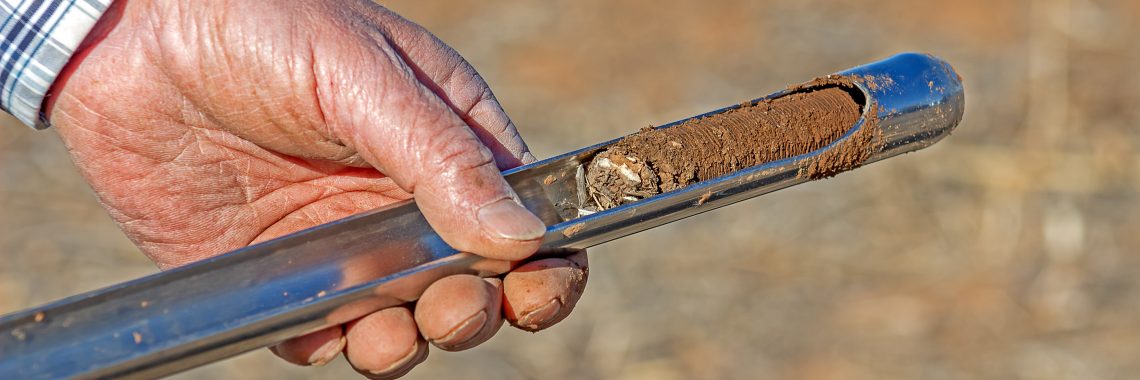This year, fertilizer prices have increased by as much as 230 percent compared to last year (Fike, 2022). Testing your soil is inexpensive and essential to making good management decisions about fertilizer, manure, and lime application rates. Studies performed by Kastens and Dhuyvetter concluded that a farmer could save $4-5 USD per acre on fertilizer by relying on accurate soil testing reports (Ward Labs). Cutting back on soil testing could result in lowering profits (Ruiz Diaz and Taylor, 2014).
Whether you are planting forages, crops, or a garden, a soil test is the best way to determine what nutrients your soil needs. Knowing what your soil is lacking can ensure that appropriate nutrient and amendment applications are applied. Applying the correct amount can reduces input cost and environmental impact, while increasing crop yield.
If you want to improve your lawn or garden, applying the correct amount of fertilizer is key. The only thing worse than starving a plant of nutrients is to accidentally over-fertilize it. Plants use only the nutrients that they need. Absorbing more than necessary can result in abnormal growth or adverse effects.
If you apply fertilizer without knowing what your soil needs, you may over- or under-apply certain nutrients. Knowing the nutrient status variability in a field, lawn, or garden means fertilizer application can be adjusted to more closely meet the supplemental nutrient needs for specific areas. Additionally, knowing the nutrient status of your soil can help you decide if it is necessary to fertilize this year based on management goals and resources.
When collecting soil cores using a soil probe, it is important to obtain random samples throughout the sample area (field, lawn, or garden). It is also important to avoid non-representative areas (i.e. eroded areas, riparian areas, etc). However, these areas and other areas that you suspect may be different should be sampled separately (Ferguson et. al., 2007).
It is recommended to collect 10-15 core samples and composite into 1 soil sample for an area of up to 40 acres. The core samples should be taken from 0-8 inches deep to analyze surface soil samples. Subsoil samples should be taken from 8-36 inches or 8-24 inches and 24-36 inches to test for residual nitrate. Any vegetation or thatch should be removed from the soil cores before combining them all into one container (Browning, 2011). If you do not have a probe, a soil sample can be taken with a spade using furrow slices at the same depths as the core samples.
One of the most common and recommended soil analysis packages for crops and gardens is the S-4 routine analysis, which costs $20/sample. This test measures pH, buffer pH, sum of cations (CEC), base saturation, soluble salts, organic matter, nitrate-nitrogen, phosphorus, potassium, calcium, magnesium, sodium, sulfur, zinc, iron, manganese, and copper. I it is important to choose the analysis package best suited to your management goals.
Soil testing labs can provide recommendations based on your soil analysis and your local Extension educator can also help make suggestions. For best results, it is important to apply fertilizer at the right time, which depends on what you are growing and its growing season.
Summary
With such expensive fertilizer prices, it is important to test your soil. Testing your soil is economically beneficial as it can used to ensure that the proper rate of fertilizer is being applied. Applying the correct amount and type of fertilizers can reduce input cost and environmental impact, while increasing crop yield. For more information, please visit www.uwyo.edu/uwe/county to contact your local extension office.
Sources for Further Reading on Testing Your Soil
- Browning. S., 2011. Soil Testing and Amending (SoilTest). University of Nebraska Lincoln. https://lancaster.unl.edu/hort/articles/2011/ SoilTest.shtml
- Ferguson. R. B. et. al., 2007. Guidelines for Soil Sampling. University of Nebraska Lincoln. Neb Guide. https://extensionpublications.unl.edu/ assets/pdf/g1740.pdf
- Fike. E., 2022. Wyoming Farmers Being Hit With High Fertilizer, Other Cost. Sheridan Media. https://sheridanmedia.com/news/101622/wyoming-farmers-being-hit-with-high-fertilizer-other-costs/
- Ruiz Diaz. D. and Taylor. M., 2014. The economic return to soil test information. Kansas State University. https://webapp.agron.ksu.edu/agr_ social/m_eu_article.throck?article_id=390
- Ward Laboratories Inc. https://www.wardlab.com/
Additional Resources from UW Extension
- Alkaline Soils in Wyoming
- Methods and Techniques for Soil Moisture Monitoring
- From the Ground Up videos:
- Barnyards & Backyards magazine Soils and Fertilization Resources – Resources available: getting started finding out what you have, managing your soil, and improving your soil
—Alex Orozco, Extension Educator, Crook County, University of Wyoming, aorozcol@uwyo.edu
Reference to commercial products or trade names is made with the understanding that no discrimination is intended and no endorsement by University of Wyoming is implied.





